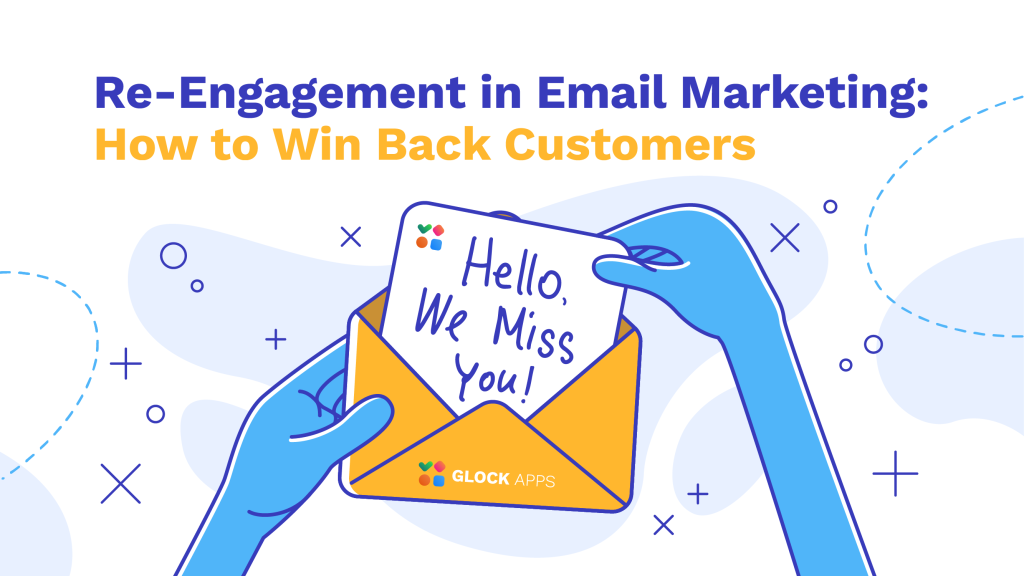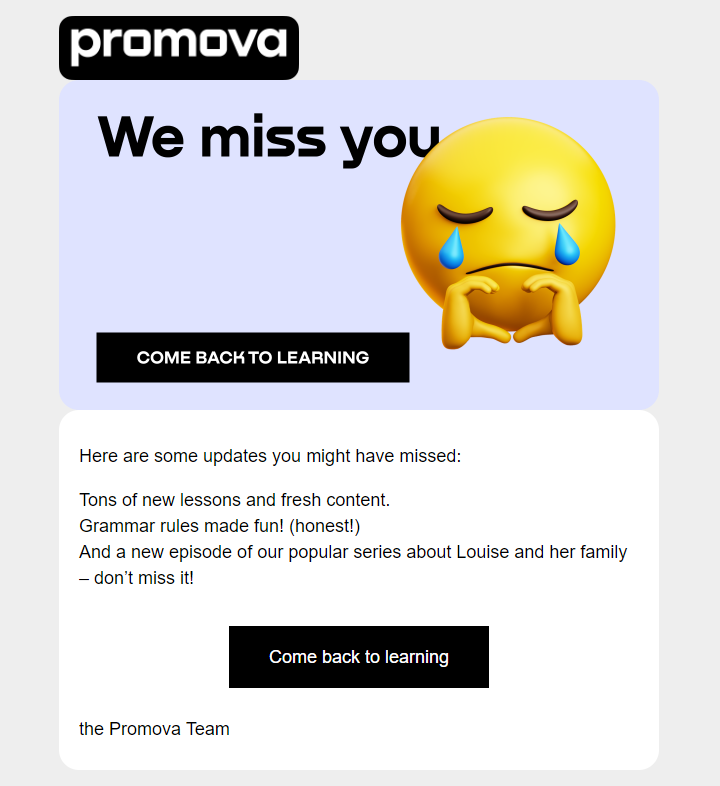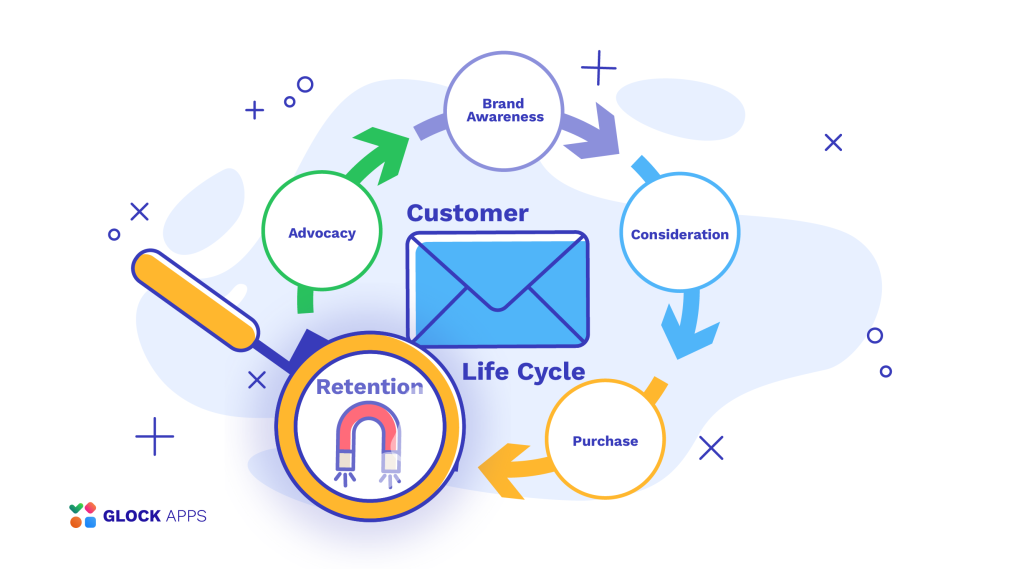Re-Engagement in Email Marketing: How to Win Back Customers

Table of contents
Why Is It Important to Win Back Customers?
Winning back customers is not just a strategic move, it’s a must for successful marketing. As is commonly believed, the whole point of email marketing is to generate new leads, guide them toward becoming clients, and ultimately convert them into brand advocates. When in fact the customer retention stage is the most important and dominant aspect in a customer lifecycle, and it really should be a concern for everyone involved.
If you, like many email marketers, often focus on acquiring new subscribers and growing your mailing lists, change your strategy to retain the subscribers you already have. Different forms of customer retention email marketing campaigns help to minimize list churn. Additionally, incorporating re-engagement emails can specifically target inactive subscribers, breathing new life into your email strategy and fostering long-term customer relationships.
As we revealed in the previous article, email list churn is a common problem, with many lists losing up to half of their subscribers each year. Apart from the visible “transparent churn” where individuals actively unsubscribe, there’s the less apparent “opaque churn.” This occurs when subscribers cease engagement without officially unsubscribing, making it challenging to track their decline.
What Is a Re-Engagement Email?
Re-engagement emails, also known as win-back or revival emails, serve as effective tools for reconnecting with inactive subscribers. These messages are strategically designed to revive interest and engagement from individuals who have shown signs of disinterest or have lapsed in their interactions with a brand.
Re-engagement emails offer a chance to win back these unengaged subscribers and rekindle their interest in your content. Alternatively, they help accurately clean your lists by identifying and removing recipients who have stopped opening emails but remain technically “subscribed”.
The idea behind re-engagement emails is quite simple. It’s far cheaper to reactivate customers than it is to acquire new ones. Moreover, win-back and lapsed purchase emails achieve a remarkable 460% higher conversion rate compared to promotional email campaigns.
Here’s a great example of a re-engagement email from the Promova app:

How to identify inactive subscribers for the re-engagement email campaign:
- 90 days of inactivity: The customer is showing signs of waning interest in your brand
- 90-120 days of inactivity: The client is at a high risk of lapsing, indicating an imminent loss
- 120-180 days of inactivity: The customer has officially lapsed, ceasing interactions with your brand
Why Prioritize Re-Engagement Campaigns in Your Email Marketing Strategy?
Re-engagement emails are pivotal in extracting the full value from your list-building and lead-generation endeavors. They play a crucial role in extending subscribers’ interest beyond the initial customer acquisition phase.
Here are some reasons why you should prioritize re-engagement campaigns:
- The worth of a re-engagement email campaign extends beyond mere monetary gains. It contributes to customer retention, a key factor in the evolving landscape of e-commerce. Existing clients not only showcase higher average order values (AOV) but also present a more cost-effective approach compared to acquiring new customers.
- The value of a re-engagement campaign involves more than financial considerations. It accelerates sales cycles, allowing you to connect with customers familiar with your brand. This direct approach skips the typical awareness stage and heads straight to the bottom of the funnel.
- Moreover, investing in re-engagement campaigns leads to lower customer acquisition costs. As loyal customers become a powerful asset, providing referrals and promoting brands on social media, the cost-effectiveness of engaging existing users becomes apparent.
- Additionally, re-engagement emails facilitate improved list management by helping identify inactive subscribers. Periodic pruning of these subscribers ensures a healthy and engaged audience. Failure to regularly revitalize your subscriber list can lead to adverse consequences, affecting your deliverability, sender reputation, and overall email marketing metrics.
- Continuing to accommodate unengaged subscribers can harm your deliverability and sender reputation. Inactive email addresses may result in bounce backs, negatively impacting your standing with internet service providers. Consistently ignored messages may lead to emails being classified as spam, posing a serious threat to your deliverability.
- Also, maintaining unengaged subscribers distorts your metrics, impacting engagement and conversion metrics. This can misguide your targeting decisions, leading to ineffective campaigns and resource misallocation. Furthermore, overlooking the signals from unresponsive subscribers may cause you to miss alternative engagement opportunities outside of email.
- In essence, a well-executed re-engagement strategy not only revitalizes your subscriber list but also safeguards your sender reputation, optimizes resources, and ensures strategic alignment with the evolving dynamics of customer engagement.
How to Use Email Marketing Strategies for Customer Retention?

Let’s delve into some theory and explore the reasons behind the importance of keeping users engaged.
Retention, the fourth stage in the customer lifecycle following Awareness, Acquisition, and Development, marks a shift from revenue maximization to building lasting relationships, fostering brand loyalty, and ensuring ongoing customer satisfaction. This phase aims to create a strong bond with customers, motivating buyers to make additional purchases or transactions and transforming them into loyal brand advocates.
In the customer retention stage, the focus moves from acquiring new customers to nurturing and maintaining existing relationships. This crucial phase aims to keep customers engaged, satisfied, and loyal to your brand. To ensure the continuation of the customer’s journey, retention becomes necessary.
Clients may sometimes doubt their decision to purchase from you. Implementing retention email marketing strategies and building personalized campaigns can play a vital role in addressing these doubts and fostering a sense of loyalty. This can include various tactics such as loyalty programs, personalized offers, and excellent customer service. Smart marketers utilize methods such as milestone emails, celebrating anniversaries, or even choosing to make loyalty cards to anticipate meaningful moments with the user.
During the retention stage, customer behavior focuses on “soft,” engagement-related actions. These behaviors are subjective and emphasize aspects like customer satisfaction, brand preference, and intent to refer. Analyzing and tracking customer behavior and identifying patterns that drive customer loyalty or churn helps to understand and refine the strategy in time. For example, companies need to know what motivates customers to stay with them, such as a personalized experience or consistent product/service quality. On the other hand, they need to identify what drives customers away, such as poor customer service or lack of value.
What Are Customer Retention Emails?
Consistent engagement through retention emails helps to establish lasting connections with your audience.
Customer retention emails are essential for keeping your brand at the forefront of buyers’ minds. The statement “stay visible to stay memorable” is also relevant to the business world. Once a customer signs up, subscribes, or makes a purchase, it’s crucial to maintain regular communication. These retention email examples serve as reminders to buyers about how your offerings can enhance their lives. If a consumer interacts with your brand once and doesn’t receive further communication, there’s a high likelihood they will forget about your brand over time.
Ensure customer retention by personalizing their experience after a purchase. At this stage, it’s crucial not to overlook customers once a transaction is completed. Implement automated email systems to express gratitude immediately after purchase or reach out personally post-shipping to confirm satisfaction. Making customers feel cared for post-purchase is as essential as pre-purchase engagement.
Employ customer service surveys to get valuable feedback and identify areas for improvement. Using information from customers allows us to continuously improve products, services, and the overall client experience.
Implementing automation is key to scaling personalized engagement as your customer base grows. Marketing automation solutions become invaluable for customer retention email creation. By integrating it with your contact base, you can efficiently convert user information into relevant and valuable content templates. For instance, set up workflows to automatically notify customers about new products or services, ensuring continuous communication and an active relationship.
Wrapping Up
In essence, re-engagement emails are not just a tool, they serve as a beacon that guides your customers safely back to the harbor. Filled with creativity, a touch of emotional involvement, and a deep understanding of your customers, you have the ingredients to create an email re-engagement campaign that brings back inactive customers.
While acquisition is crucial for business expansion, customer retention brings a host of benefits that contribute to sustained growth. Allocating resources to effective customer retention strategies not only minimizes costs but also enhances revenue, fostering a loyal customer base. Use a customer retention email strategy and watch your recipient’s engagement reach new heights.



